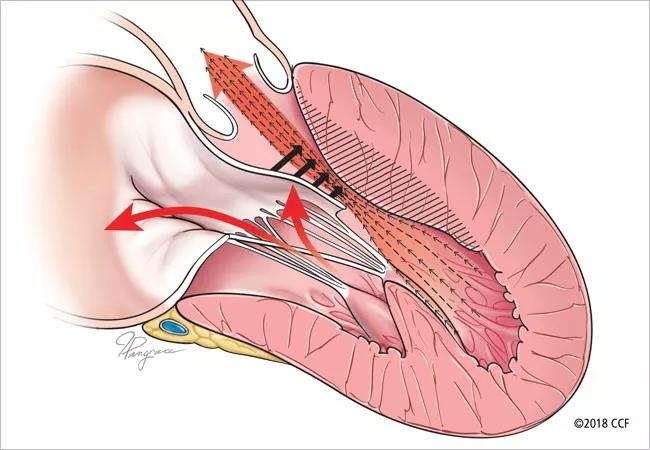Large study suggests adding myectomy and afib to the equation

Risk stratification for sudden cardiac death (SCD) in patients with obstructive hypertrophic cardiomyopathy (HCM) appears to need some refining, particularly for patients who undergo myectomy. So concludes a retrospective observational study of a large cohort of patients with obstructive HCM evaluated at Cleveland Clinic.
Cleveland Clinic is a non-profit academic medical center. Advertising on our site helps support our mission. We do not endorse non-Cleveland Clinic products or services. Policy
The study, reported online by the Journal of Thoracic and Cardiovascular Surgery, found little correlation between actual rates of SCD and the rates predicted by risk models for SCD from recent European Society of Cardiology (ESC) guidelines or American College of Cardiology/American Heart Association (ACC/AHA) guidelines.
The authors reviewed 1,809 consecutive patients with obstructive HCM evaluated at Cleveland Clinic from 1997 to 2013. For all patients they recorded the number of major SCD risk factors (0, 1 or ≥ 2) and calculated the five-year ESC risk score for SCD. The researchers also noted whether surgical myectomy was performed and whether patients experienced the study’s primary composite end point of SCD or appropriate discharge of an implantable cardioverter defibrillator (ICD).
Patients were assigned to three groups according to their five-year risk of SCD based on ESC risk score:
The researchers then compared the groups’ expected event rates based on the ESC risk model with their actual observed event rates.
Across the study’s full follow-up period (mean, 8.8 years), a primary composite event occurred in 169 patients (SCD in 154, ICD discharge in 15). Of those events, 88 occurred within five years of follow-up — i.e., the time frame addressed by the ESC five-year risk score.
At five-year follow-up, despite a wide range of expected event rates among the three risk groups (2.5 percent to 9 percent), the observed event rates were statistically comparable among the three groups: 5.0 percent for low-risk patients, 4.6 percent for medium-risk patients and 4.8 percent for high-risk patients.
“Notably, in the highest SCD risk group, the actual five-year event rate [4.8 percent] was only about half the expected event rate based on ESC risk score [9 percent],” observes the study’s lead author, Milind Desai, MD, Professor of Medicine at Cleveland Clinic Lerner College of Medicine and a Cleveland Clinic cardiologist.
Risk assessment based on the ACC/AHA risk model had a similarly poor predictive value for actual event rates.
A full 64 percent of patients in the analysis underwent surgical myectomy to relieve their obstructive HCM. On multivariable analysis, the researchers found that myectomy was associated with reduced risk of a longer-term composite event (hazard ratio = 0.69; 95% CI, 0.47-0.83), whereas ESC risk score was not.
“We found that in patients with a higher ESC risk score, myectomy may reduce risk at five years,” notes study co-author Nicholas Smedira, MD, of Cleveland Clinic’s Department of Thoracic and Cardiovascular Surgery.
Multivariable analysis also showed that atrial fibrillation during follow-up was associated with increased risk of a composite event.
The researchers concluded that adding myectomy and atrial fibrillation to the ESC risk score for SCD significantly reclassified risk and provided incremental prognostic utility.
“In the context of HCM, our field has talked about sudden death risk and symptoms as two separate things,” Dr. Desai observes. “People say the risk of sudden death is driven by arrhythmias, possibly by myocardial fibrosis and disarray. And symptoms are thought to be driven mostly by diastolic dysfunction and outflow tract gradient. What our study suggests is that relieving the obstruction in HCM, debulking the thick myocardium, could potentially also have an impact in reducing sudden death.”
While noting that these findings need to be reproduced in other settings, Dr. Desai says they may herald a notable shift in practice: “I think we are entering an era with surgical myectomy where we’re talking not just about symptom relief but also about modulating longer-term risk of dying.”

Surprise findings argue for caution about testosterone use in men at risk for fracture

Findings support emphasis on markers of frailty related to, but not dependent on, age
![GettyImages-1252287413 [Converted]](https://assets.clevelandclinic.org/transform/StoryPanel/350804b2-f1e4-4d97-a277-9629cf45af3e/23-HVI-4120348_redlining_650x450_jpg?w=3840&q=75)
Large database study reveals lingering health consequences of decades-old discrimination

Additional analyses of the two trials presented at 2023 ESC Congress

Prospective SPIRIT-HCM trial demonstrates broad gains over 12-month follow-up

An ACC committee issues recommendations to accelerate sluggish progress

Review of our recent experience shows it’s still a safe option

Machine learning may improve risk prediction and guide therapy